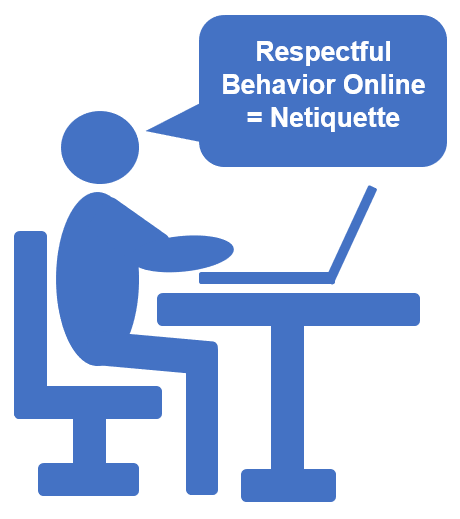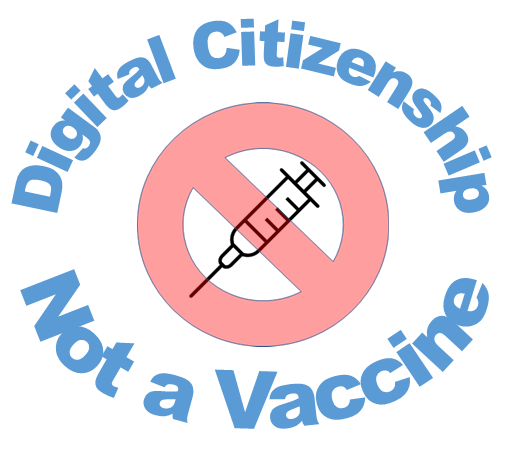Many things possible today through the use of technology were not possible just a few years, months, days, or even seconds ago. Technology can amplify all types of human behavior. Ribble and Park (2019) point out, “Digital technologies are accelerators. When used for good, the benefits are abundant and easily celebrated…the same technologies can accelerate intimidation, threatening behavior, or bullying” (p. 79). In addition, internet access lets the user be somewhat invisible and hide behind a mask (screen). When engaging in online activities, the user can both lurk in the shadows or be public in a way that was not possible a few years ago.
Educators are used to being able to see when problems are happening in their classroom and could intervene immediately. However, with devices, students can engage in a world that may be invisible to their teacher and their families. This can have scary consequences. Below are tips to help students engage in positive classroom netiquette and to help them develop an understanding of cyberbullying.
Classroom Netiquette
Classroom netiquette is essentially respectful behavior online. We need to clearly identify what respectful means because it can mean different things for different people and in different cultures. Once identified, we should expect students to behave in civil and respectful ways in both physical and digital spaces. It is very important that we teach students how to engage in respectful behavior online, or netiquette, because in a digital environment, there are no visual or physical cues to help others understand each other.

12 Tips to Help You and Your Students Engage in Appropriate Classroom Netiquette
- Apply real-world rules. If it is a rule in your face-to-face classroom, it is still a rule in your digital classroom.
- Be aware of text tone. Tone comes across very differently through text than through conversation. Things like sarcasm or joking will often just come across as mean and inappropriate. Try to be direct and polite.
- Don’t type in all caps. It comes across as if you are yelling. If you wouldn’t yell at the person in real life while having a conversation with them, then you should never use all capital letters.
- Be kind! Just because someone can’t see your face or may not know your name does not mean you should be unkind. A remote classroom is still a classroom, and you should never say or do things online that you wouldn’t say or do in a face-to-face classroom.
- Chat boxes aren’t really for chatting. They are for engaging in meaningful, purposeful, and public conversation. If you wouldn’t raise your hand to share what you are about to say with the whole class or in a small-group conversation, it probably shouldn’t go in the chat.
- Use proper grammar to the best of your ability. Don’t use social media slang or cute ways of spelling when showing your understanding. Doing so could be very frustrating for others, especially for those who don’t have the same understanding, reference, or background that you do.
- Read first, then ask questions. Make sure and read previous discussions and instructions before you ask a question that may have already been answered, perhaps several times.
- Think before you type…hit enter…and/or hit send! When you share something online, it is shared forever. It is permanent and can’t be taken back. Be as respectful to others as you would like them to be to you. Don’t overshare personal information that is not relevant, and never share private information, such as your address, passwords, etc.
- Respect people’s privacy. Don’t share information about others, even your family and friends, that is private and/or personal. Anything shared digitally is easily copied and can be shared in a very quick amount of time.
- Before you share something, make sure that it is true. Know the sources of your facts. If you don’t know if something is true or not and you cannot find other reliable sources to back it up, don’t post or share it.
- Always give credit to the original source. Copyright law, fair use, and Creative Commons are important.
- Practice, practice, practice! Take the time to revisit netiquette guidelines and practice them. Mistakes will happen, but it is better to practice in a safe environment now rather than make mistakes outside of a digital classroom, where the stakes are higher and people and life aren’t so forgiving.
To help teach and reinforce these concepts, a poster that you can share with your students is included below. Feel free to make a copy to customize as needed for your learners.
Cyberbullying
According to Erin Wilkey Oh with Common Sense Education (2019), “Cyberbullying is the use of digital media (such as websites, apps, and text messages) to intimidate, upset, or harm someone. It includes repeatedly sending, posting, or sharing negative, harmful, or mean content about someone else on purpose.” As more students have access to unsupervised online environments, there is a greater risk for cyberbullying to increase if both educators and caregivers don’t step in and provide support.
7 Ways to Provide Support Around Cyberbullying
- You need to be aware that all of your students and their parents/guardians are going to have different levels of understanding around digital citizenship. Just like with any other content area, you can’t make assumptions around what students do and do not know, and you will need to differentiate your instruction accordingly.
- Be aware of the strategies that your district and/or school have for identifying and addressing cyberbullying. Make sure that your students are aware of and understand the district and/or school policy around cyberbullying.
- Discuss cyberbullying with your students—not just what it is, but how it can affect all parties involved. This could include the bully/bullies, the victim(s), and the bystanders.
- Provide examples of what cyberbullying is and where it can take place.
- Share with students several questions they might want to answer before ever positing anything that might result in cyberbullying:
- Would I want my parent/guardian to see or read what I am about to post?
- Could this negatively affect my future or someone else’s future?
- Could this hurt anyone’s feelings?
- How might this make me or someone else look to others?
- Share with students how to report cyberbullying, whether it is happening to them or someone they know. Make sure students understand that even if cyberbullying is happening outside of school grounds, outside of school hours, or even using non-school devices, they can and should still report it to their parents/guardians, a teacher, a counselor, or an administrator as soon as possible. If there are specific procedures for reporting cyberbullying in your district and/or at your school, share that information with students and parents/guardians.
- Get parents/guardians and the community involved. Host a community café or forum around digital citizenship and cyberbullying. Again, share information about cyberbullying with parents/guardians. Below are several great resources from Common Sense Education that could be shared:

We need to remember that digital citizenship is not a vaccine! It is not a single lesson or a one-time event. Educators need to constantly be providing opportunities for students to engage in ethical and responsible uses of technology, while also making students aware of the ethical, emotional, and even illegal activity and damage that can happen if they do not. We need to continually create positive and connected digital experiences for our students that provide ample opportunities for them to engage in and practice positive digital citizenship. We need to constantly be thinking about how we can embed and teach soft skills, such as empathy, when having students engage in a digital environment. You might check out the ISTE Standards for Educators and the ISTE Standards for Students to support you when developing positive digital experiences.
Extend Your Learning
- Teaching Students Cyber Ethics (Education Week)
- Promoting Responsible and Ethical Digital Citizens (Education World)
- Teachers’ Essential Guide to Cyberbullying Prevention (Common Sense Education)
References
- Ribble, M., & Park, M. (2019). The digital citizenship handbook for school leaders: Fostering positive interactions online.
International Society for Technology in Education.
- Wilkey Oh, E. (2019). What is cyberbullying? How common is it? And what can teachers do about it? Get advice and resources to support your students. Common Sense Education.
